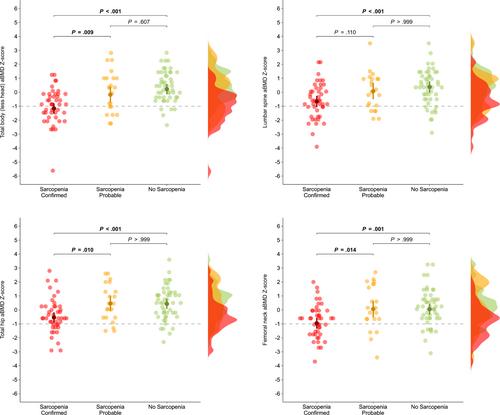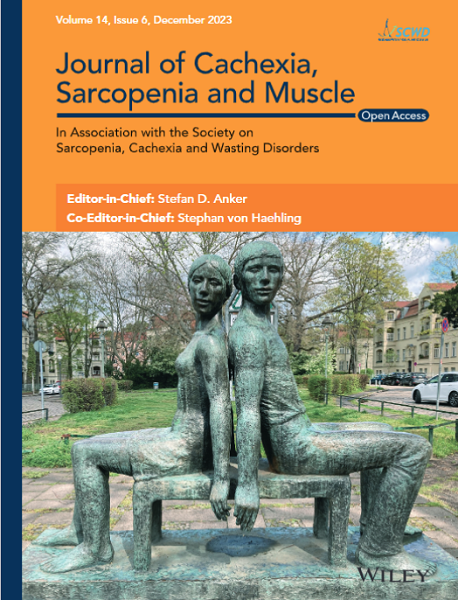Sarcopenia and low areal bone mineral density (aBMD) are prevalent musculoskeletal complications after paediatric cancer treatment. However, their relationship has not been examined in young paediatric cancers survivors. This study aimed to evaluate aBMD differences according to sarcopenia status and the risk of low aBMD Z-score in young paediatric cancer survivors with sarcopenia confirmed/probable.
This cross-sectional study included 116 paediatric cancer survivors (12.1 ± 3.3 years old; 42.2% female). Handgrip strength was used to assessed muscle strength. Dual-energy X-ray absorptiometry estimated aBMD (g/cm2) and appendicular lean mass index (ALMI, kg/m2). ‘No sarcopenia’ was defined when muscle strength was >decile 2. ‘Sarcopenia probable’ was defined when muscle strength was ≤ decile 2 and ALMI Z-score was > −1.5 standard deviation (SD). ‘Sarcopenia confirmed’ was defined when muscle strength was ≤ decile 2 and ALMI Z-score ≤ −1.5 SD. Analysis of covariance and logistic regression, adjusted for time from treatment completion, radiotherapy exposure, calcium intake, and physical activity, was used to evaluate aBMD and estimate the odds ratios (ORs) of low aBMD (aBMD Z-score < −1.0).
Survivors with sarcopenia confirmed had significantly lower aBMD than those without sarcopenia at total body (−1.2 [95% CI: −1.5 to −0.8] vs. 0.2 [−0.2 to 0.6], P < 0.001), lumbar spine (−0.7 [−1.1 to −0.3] vs. 0.4 [0.0 to 0.8], P < 0.001), total hip (−0.5 [−0.9 to −0.2] vs. 0.4 [0.1 to 0.8], P < 0.001), and femoral neck (−1.0 [−1.4 to −0.6] vs. 0.1 [−0.3 to 0.4], P = 0.001). Compared with survivors with sarcopenia probable, survivors with sarcopenia confirmed had significantly lower aBMD Z-score at total body (−1.2 [−1.5 to −0.8] vs. −0.2 [−0.7 to 0.4], P = 0.009), total hip (−0.5 [−0.9 to −0.2] vs. 0.5 [−0.1 to 1.0], P = 0.010), and femoral neck (−1.0 [−1.4 to −0.6] vs. 0.1 [−0.5 to 0.7], P = 0.014). Survivors with sarcopenia confirmed were at higher risk of low aBMD Z-score at the total body (OR: 6.91, 95% CI: 2.31–24.15), total hip (OR: 2.98, 1.02–9.54), and femoral neck (OR: 4.72, 1.72–14.19), than those without sarcopenia. Survivors with sarcopenia probable were at higher risk of low aBMD Z-score at the total body (OR: 4.13, 1.04–17.60) than those without sarcopenia.
Young paediatric cancer survivors with sarcopenia present higher risk of low aBMD. Resistance training-based interventions designed to mitigate osteosarcopenia in this population should be implemented at early stages.



